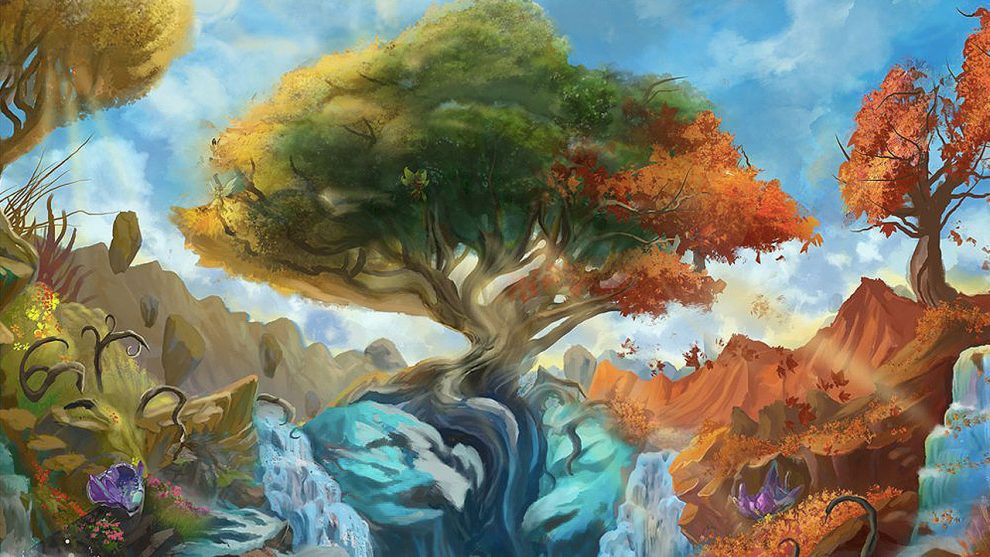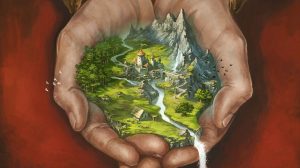Disclosure: Meeple Mountain received a free copy of this product in exchange for an honest, unbiased review. This review is not intended to be an endorsement.
Overview
The game of Groves takes place in the fantasy realm of Idyllon. The queen of the realm, Nivarra, has passed on and left the shared rulership to the players, the guardians of the realm. Each player will take on the role of one of these guardians as they work to become the sole ruler of Idyllon. Utilizing elements of worker placement, resource management, and bag building, each player will be gathering resources that they will use to add “groves” to their domain.
These groves provide new opportunities for resource gathering, victory points (called “dominion points” in this game), and also access to the “spirits” that are required in order to utilize each grove’s abilities. When the game finally ends, the player who has the most victory points will win.
Contents

Groves comes in a small, rectangular box that is stuffed full of components. There are a wide array of hexagonal Grove cards which I’ll talk about it in more detail shortly. In addition there are an assortment of other, more standard looking cards – Summoning Bonus cards, Realm Bonus cards, Dominion cards, and Portal cards. There are also several small square tokens that are used to represent the different elements – earth, water, and air – as well as the crystals (in 3 denominations) which are used to purchase some of the items in the game.
In addition to these square tokens, there are also some round tokens which represent the various types of spirits – the same tokens that will be drawn out of the bags that have been provided for each of the players. These spirits come in several colors – white, yellow, orange, green, red, and black (called ‘wraiths’) – and these colors play an important role during the course of the game. Aside from the components I’ve already mentioned, there is a rule book, a starting player token (the crown), and a central game board which is referred to in the rules as the Tree of Idyll. Just to keep things simple, I’ll refer to it as “the Tree” whenever it comes up in this review.

Since this is a prototype, I can’t make any comments as to the state of the final game. However, it is a very nice prototype as far as prototypes go. One of the things that made me the happiest is that Letiman Games were thoughtful enough to include some plastic baggies so that I would be able to store things after I’d dug into the box. That was a very nice touch! Another thing that I can comment on is the art. The artwork for this game is fantastic and that comes as no big surprise considering it’s all done by Nolan Nasser. In case you haven’t heard of Nolan, he did the artwork for New Bedford as well as Nantucket. His work here is no less awe inspiring. His usage of warm, earthy colors perfectly conveys the feel of the narrative.
Setup
Each player selects a color and takes the bag of that color. Into this bag, they will place 8 white spirit tokens. Each player also receives a starting Grove card which provides them with crystals and one that provides them with additional spirits for their bag. Next, a starting player is determined by some means. The player to their left, and moving counter clockwise, will select one of the other starting Grove card types and will place a spirit matching that Grove card’s color into their bag. Each player also begins with two of each type of element token and a number of crystals which is determined by player order.
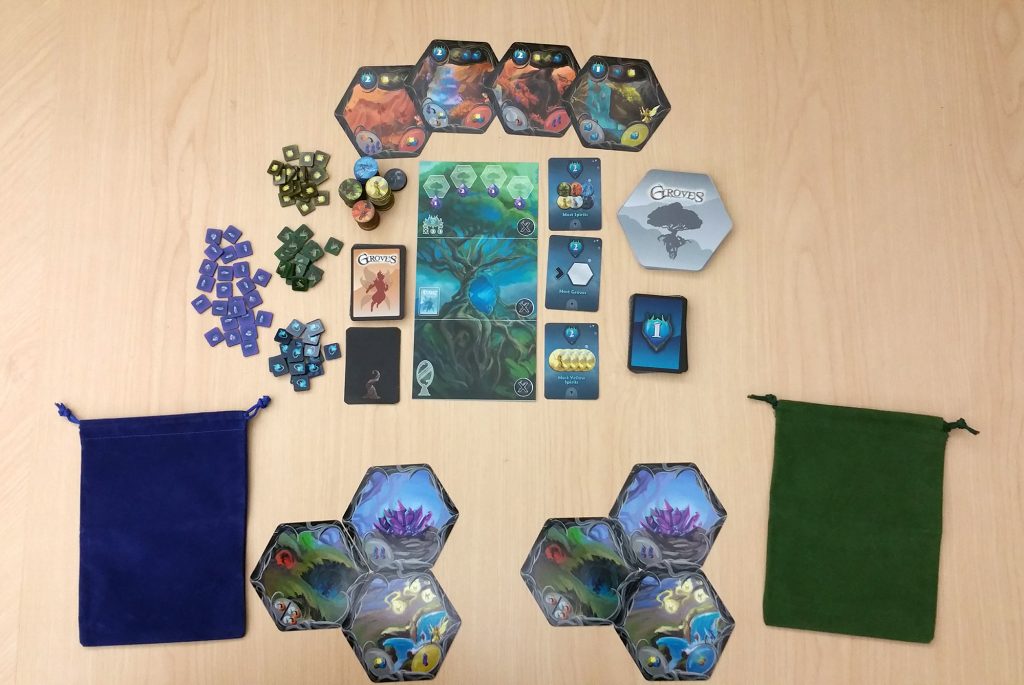
The Tree is placed between all of the players and the various tokens are sorted and placed into piles closeby. The cards are shuffled into their specific decks and placed facedown closeby as well with the exception of the Realm Bonus deck. Three cards are drawn off of the top of this deck and placed face up next to the Tree and the remainder of these cards are returned to the box as they will not be needed. Four Grove cards are drawn off of the top of the deck and placed along the top of the Tree in a row. With all of this set out, you’re ready to begin.
The Cards
As I mentioned previously, there are quite a few different cards in this game. In order to understand how the game is played, it’s easier, I think, if you understand what each of the different cards represents. So, here they are:

Grove cards: each Grove card shares several design elements in common. At the top of the card is a blue flame with a number in it. This blue flame represents how many dominion points (VP) the card will be worth at the end of the game. Next to this are icons representing the various elements needed to purchase the card. At the bottom left corner of the card are icons which describe the card’s basic action. The bottom right corner of the card contains the card’s bonus action. The only cards that do not adhere to this convention are the starting Grove cards.

Summoning Bonus cards: these cards each display the number of VP they’re worth and each features iconography that describes the bag pull combinations which can be used to claim the card. I’ll get to the bag pull soon.
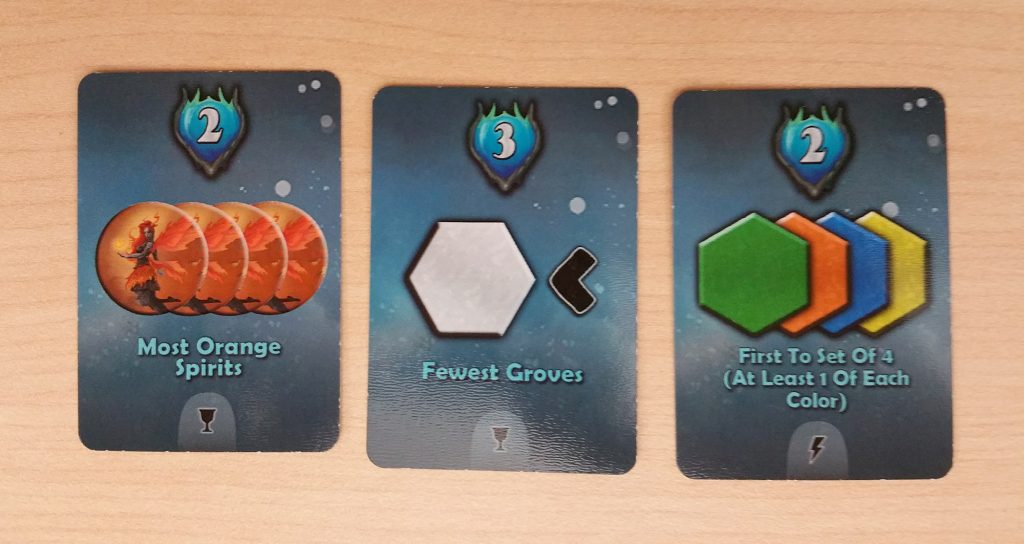
Realm Bonus cards: these cards display the number of VP that they’re worth as well as iconography that details what pre-requisites must be met in order for a player to claim the card.

Portal cards: one side of these cards shows a portal base and the other side shows the image of a fully formed portal. In order to be able to send their spirit tokens into their opponents’ realms, the players must first construct portals to those realms.
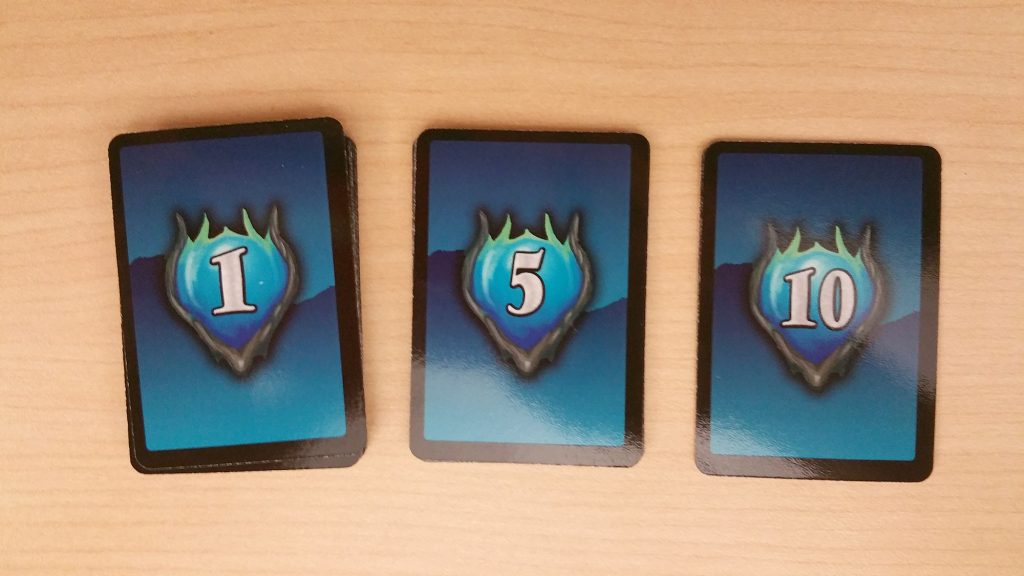
Dominion cards: these cards are provided as a handy method of keeping track/counting the amount of VP that each player has.
Grove Card Bonuses
Every Grove card has a color affiliated with it. This color appears as the background color in the bonus area of the card. If a player uses a spirit token whose color matches the bonus color, then the player will not only collect from the card’s generic ability, but they will also collect from the bonus as well.
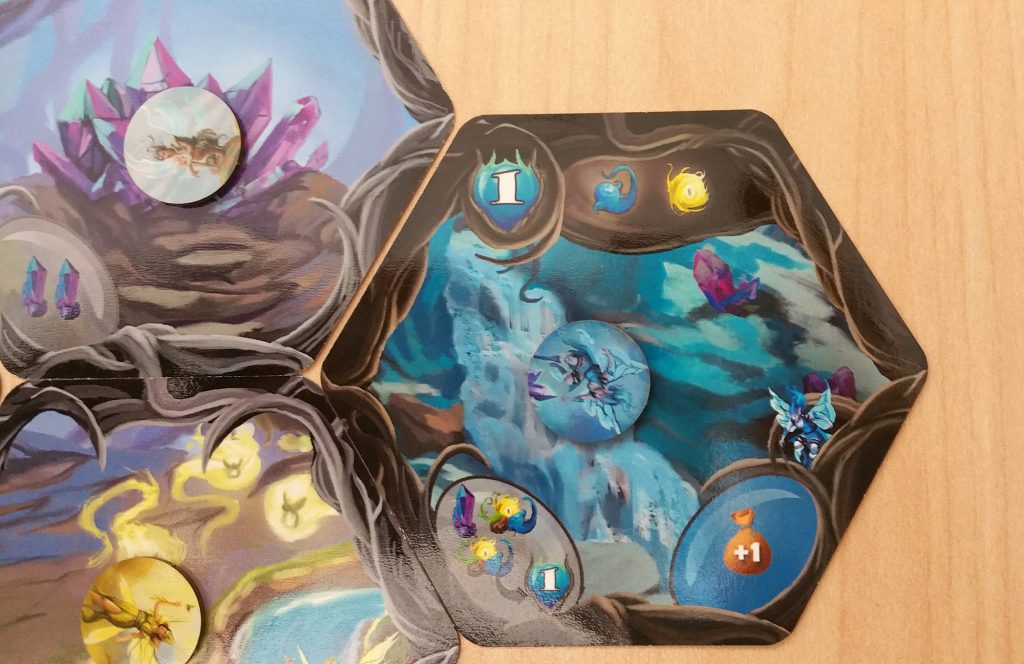
How the Game is Played
Each round begins in the same way. The players reach into their bags and draw out three spirit tokens. Then the players take turns performing actions with these tokens. Like a lot of worker placement games, once a spirit token has been placed onto a Grove card in order to perform that card’s action, that action becomes unavailable for the remainder of the round. The actions of the Grove cards vary from card to card, but they will typically award the players with extra element tokens or crystals or the ability to add spirits to their bags.
Players may also place their spirit tokens onto the Tree. Unlike Grove cards, the actions on the Tree can accommodate any number of spirit tokens. The Tree is divided into three sections. The upper section allows the players to purchase additional Grove cards from the lineup to add to their tree. The Grove card furthest to the left will always cost 1 crystal plus the elements depicted on the card. The one next to it will cost 2 crystal plus the elements depicted on the card. The next will be 3 crystals and the elements while the last one will cost four crystals plus the elements. When purchased,the purchasing player will add the Grove card to their player area, but the Grove card display above the Tree does not refill.
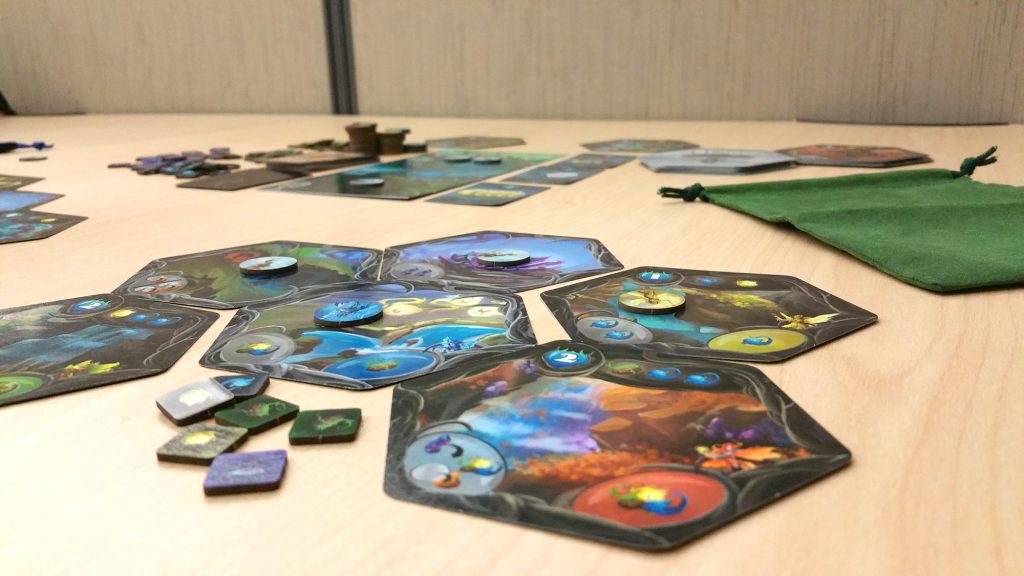
The middle tier of the Tree allows the player to acquire Summoning Bonus cards. A player may have as many of these cards in their possession as they want at any given time, but they are kept secret until the player manages to draw out the spirit tokens needed to satisfy the conditions on the card (i.e. – 3 spirit tokens of different types, etc.).
The bottom tier of the Tree allows players to construct portals. Each portal begins with a base. The second time that a player sends a spirit to this location, the portal base is flipped to its completed side and the portal is placed between the player and the opponent’s realm which they wish to have access to (either to the right of left of the player). The completion of a portal will award the player with a wraith token which will be placed into their bag and will also be worth an extra VP at game’s end.
After all the players have placed all of their spirits any non-wraith tokens that are in their realm will be placed into their bags. Any spirit tokens remaining on the Tree will be returned to the supply. Wraith tokens stick around and must be chased away by other spirits on subsequent turns. They might be a nuisance, but they are very useful when it comes to collecting Grove card bonuses as they can be used as stand ins for any spirit token color of your choice.
After all of the spirit tokens have been returned to the proper bags, the first card in the Grove card row above the Tree will be discarded (if it’s still there) and the remaining cards will slide over to fill in the empty spots. Then additional Grove cards are drawn until the display once again holds four of them. The game comes to an end after the round in which the final Grove card has been drawn from the deck and added to the display. The person with the greatest amount of VP wins.
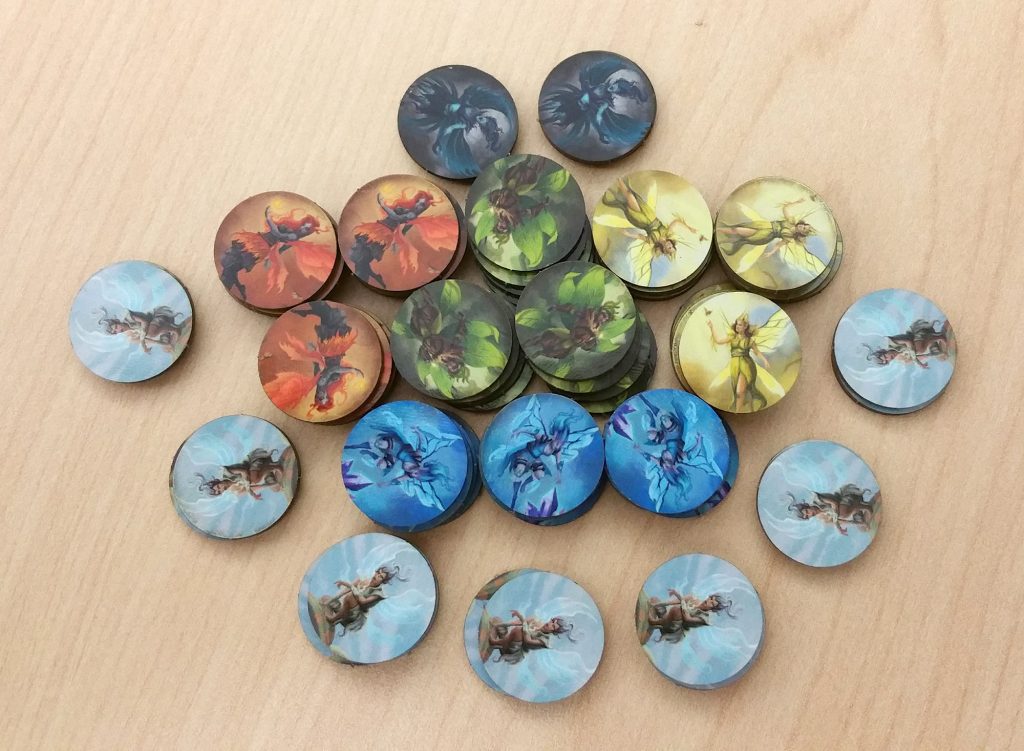
Thoughts
To start, this game has some really great artwork. The colors are bright and vibrant yet the artwork also maintains an earthy feel about it. The game takes place in a fairy enclave in a forest grove and Nolan has done an excellent job of conveying a sense of magic and wonder in each of the illustrations. He never fails to impress me. He’s definitely an artist to keep an eye on.
Groves has got a lot of good things going for it and very few negatives. For starters, the game plays pretty quickly at any player count. Since the Grove cards available in the offering act as the game’s timer the game tends to go by rather quickly. It is conceivable that a game might be played in which people aren’t adding a lot of cards to their play areas, but it isn’t likely. The key to doing well in this game is expansion.
Another aspect of the game that I like is that Groves provides you a lot of control over what comes out of your bag on each of your draws. Since any spirits sent to the Tree are returned to the supply, this means that each player has an easy method for thinning out their bag and getting rid of any unwanted spirits that might be in there. If you’ve ever played any kind of deck builder game before, you will instantly recognize the importance of getting rid of the chaff so that you’ll increase your chances of drawing the things that you need. Adding in the portals makes things even more interesting because it not only allows you to get rid of unwanted spirit tokens, but it allows you to clog up your opponents’ bags with them. This provides a welcome level of direct player interaction that a lot of deck/bag building games are sorely lacking.

All of that being said, the game isn’t perfect. One of the things that I enjoy about most of the deck/bag building games that I have played is the ability to chain together various cards or abilities into interesting and exciting combos. I just don’t ever feel that level of excitement while playing Groves. While I do enjoy my time playing it, I don’t ever walk away from the game with an awesome story to tell. I really like the feeling of pulling off something really cool and memorable but Groves isn’t really bursting at the seams with moments like those.
Another tick in the negative column is also one of the ticks in the positive column, as odd as that sounds. Because the game plays so rapidly, it’s hard to feel like you’ve actually accomplished anything. By the time your bag’s starting to fill up with spirits and your play area is starting to really pay off, the game’s over. Groves builds up a head of steam, but it doesn’t allow you to really go anywhere with it. While it doesn’t overstay its welcome, it kind of under-stays it. I just wish it were slightly longer so that I could enjoy the engine that I’ve gotten going.
Groves is a pretty decent game and it’s an excellent introduction to the concept of bag building. I’d play it again gladly if someone wanted to play it, but I don’t think I’d rush out to buy it given the choice. When it comes to board gaming, I’ve got a hearty appetite. Groves whets that appetite just enough to make me feel even hungrier, but not for more Groves. In short, Groves is a good game, but is it a great game? The answer to that question is “no”. It has the potential to be something great, but it’s not quite there yet.
What do you think about Groves? Give us your opinions about what you like and/or dislike about the game in the comments below!


